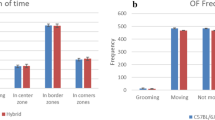Mice of two strains bred for large and small relative brain weight (BB and SB) were tested for hyponeophagy, responses in the unavoidable slippery funnel test and the test for understanding object permanence (as per J. Piaget), in which they had to find an underpass to a comfortable shelter when hidden (a cognitive test). Between-strain differences were evaluated in control mice and in groups after 2 h of restraint, which provokes the development of a stress reaction. In the hyponeophagy test, reactions to a novel foodstuff in a novel environment were significantly greater in SB mice (but not BB mice) after restraint than in controls. In the unavoidable slippery funnel test, BB mice showed significantly longer adaptive escape reactions after restraint, while this change was insignificant in SB mice. BB mice transferred from one type of response to another more frequently than SB mice. In SB mice the pattern of the ratio of the amounts of time spent in the three types of reaction in the funnel test in controls and after restraint were different from those in BB, which is evidence of between-strain differences. BB mice (total control and experimental) solved the cognitive test better than SB mice. Stress had no significant influence on measures of solving this test. These data show that differences in behavior exist between the BB and SB strains (including in the state of stress), despite cessation of selection for relative brain weight.
Similar content being viewed by others
References
Ben Abdallah, N. M.-B., Fuss, J., Trusel, M., et al., “The puzzle box as a simple and efficient behavioral test for exploring impairments of general cognition and executive functions in mouse models of schizophrenia,” Exp. Neurol., 227, No. 1, 42–52 (2011).
De Boer, S. F., Koopmans, S. J., Slangen, J. L., and Van der Gugten, J., “Effects of fasting on plasma catecholamine, corticosterone and glucose concentrations under basal and stress conditions in individual rats,” Physiol. Behav., 45, No. 5, 989–994 (1989).
Elenkov, I. J., Wilder, R. L., Chrousos, G. P., and Vizi, E. S., “The sympathetic nerve – an integrative interface between two supersystems: the brain and the immune system,” Pharmacol. Rev., 52, No. 4, 595–638 (2000).
Harris, R. B., Zhou, J., Shi, M., et al., “Overexpression of agouti protein and stress responsiveness in mice,” Physiol. Behav., 73, No. 4, 599– 608 (2001), https://doi.org/10.1016/s0031-9384.
Jiang, S. Z. and Eiden, L. E., “Activation of the HPA axis and depression of feeding behavior induced by restraint stress are separately regulated by PACAPergic neurotransmission in the mouse,” Stress, 19, No. 4, 374–382 (2016), https://doi.org/10.1080/10253890.2016.1174851.
Kulesskaya, N. and Voikar, V., “Assessment of mouse anxiety-like behavior in the light-dark box and open-field arena: role of equipment and procedure,” Physiol. Behav., 133, 30–38 (2014), https://doi.org/10.1016/j.physbeh.2014.05.006.
Malisch, J. L., Breuner, C. W., Kolb, E. M., et al., “Behavioral despair and home-cage activity in mice with chronically elevated baseline corticosterone concentrations,” Behav. Genet., 39, No. 2, 192–201 (2009), https://doi.org/10.1007/s10519-008-9246-8.
Markina, N. V., Popova, N. V., Salimov, R. M., et al., “Anxiety levels and stress reactivity in mice selected for large and small brain weight,” Zh. Vyssh. Nerv. Deyat., 49, No. 5, 789–798 (1999).
McEwen, B. S., Bowles, N. P., Gray, J. D., et al., “Mechanisms of stress in the brain,” Nat. Neurosci., 18, No. 10, 1353–1363 (2015), https://doi.org/10.1038/nn.4086.
Miyamoto, T., Funakami, Y., Kawashita, E., et al., “Repeated cold stress enhances the acute restraint stress-induced hyperthermia in mice,” Biol. Pharm. Bull., 40, No. 1, 11–16 (2017), https://doi.org/10.1248/bpb.b16-00343.
O’Connor, R. M., Finger, B. C., Flor, P. J., and Cryan, J. F., “Metabotropic glutamate receptor 7: At the interface of cognition and emotion,” Eur. J. Pharmacol., 639, No. 1–3, 123–31 (2010), https://doi.org/10.1016/j.ejphar.2010.02.059.
O’Mahony, C. M., Sweeney, F. F., Daly, E., et al., “Restraint stress-induced brain activation patterns in two strains of mice differing in their anxiety behaviour,” Behav. Brain Res., 213, No. 2, 148–54 (2010), https://doi.org/10.1016/j.bbr.2010.04.038.
Parker, C. C., Ponicsan, H., Spencer, R. L., et al., “Restraint stress and exogenous corticosterone differentially alter sensitivity to the sedative- hypnotic effects of ethanol in inbred long-sleep and inbred short-sleep mice,” Alcohol, 42, No. 6, 477–485 (2008), https://doi.org/10.1016/j.alcohol.2008.05.004.
Perepelkina, O. V., Golibrodo, V. A., Lilp, I. G., and Poletaeva, I. I., “Mice selected for large and small brain weight: The preservation of trait differences after the selection was discontinued,” Adv. Biosci. Biotechn., 4, 1–8 (2013).
Perepelkina, O. V., Tarasova, A. Yu., Ogienko, N. A., et al., “Brain weight and cognitive capacities in laboratory mice,” Usp. Sovr. Biol., 139, No. 5, 434–445 (2019).
Rygula, R., Papciak, J., and Popik, P., “Trait pessimism predicts vulnerability to stress-induced anhedonia in rats,” Neuropsychopharmacology, 38, No. 11, 2188–2196 (2013), https://doi.org/10.1038/npp.2013.116.
Salimov, R. M., “Different behavioral patterns related to alcohol use in rodents: A factor analysis,” Alcohol, 17, No. 2, 157–62, https://doi.org/10.1016/s0741-8329.
Sulakhiya, K., Patel, V. K., Saxena, R., et al., “Effect of Beta vulgaris Linn. leaves extract on anxiety- and depressive-like behavior and oxidative stress in mice after acute restraint stress,” Pharmacognosy Res., 8, No. 1, 1–7 (2016), https://doi.org/10.4103/0974-8490.171100.
Vargas-López, V., Torres-Berrio, A., González-Martínez, L., et al., “Acute restraint stress and corticosterone transiently disrupts novelty preference in an object recognition task,” Behav. Brain Res., 291, 60–66 (2015), https://doi.org/10.1016/j.bbr.2015.05.006.
Author information
Authors and Affiliations
Corresponding author
Additional information
Translated from Zhurnal Vysshei Nervnoi Deyatel’nosti imeni I. P. Pavlova, Vol. 71, No. 1, pp. 104–113, January–February, 2021.
Rights and permissions
About this article
Cite this article
Perepelkina, O.V., Ogienko, N.A., Suleimanova, A.D. et al. Restraint Stress and Behavior in Mice with Different Brain Weights. Neurosci Behav Physi 51, 947–953 (2021). https://doi.org/10.1007/s11055-021-01151-w
Received:
Revised:
Accepted:
Published:
Issue Date:
DOI: https://doi.org/10.1007/s11055-021-01151-w




